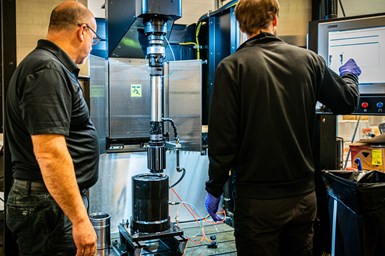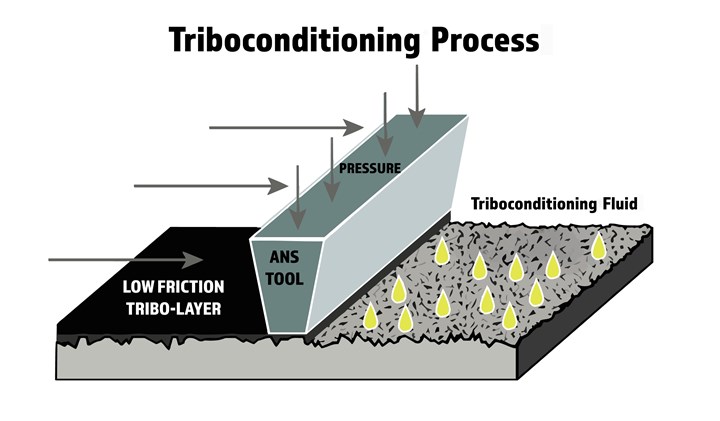
This “mechano-chemical” process can improve the tribological properties of ferrous materials such as steel and cast iron by way of burnishing/plateauing while impregnating the surface at a nano level with tungsten. Photo Credit: Sunnen
Oftentimes, honing is one of the final machining operations for parts with precision bores that must accommodate mating internal components. According to honing equipment and abrasives manufacturer Sunnen, the process can remedy various unfavorable bore conditions, including diameter size, bellmouth, waviness, taper, rainbow, barrel shape, reamer chatter, boring marks and out-of-round holes. It can achieve bore diameter tolerances of ±0.0002 inch while leaving behind its signature crosshatch pattern for lubrication retention.
Taking this a step forward, Sunnen recently partnered with Sweden’s Applied Nano Surfaces (ANS) to offer ANS Triboconditioning technology on standard Sunnen CNC honing equipment. Triboconditioning, which is a process performed after honing and very much resembles a honing operation, can improve bore surface finish and combustion sealing while lowering friction and wear between mating components.
Featured Content
It does this through what the companies refer to as a “mechano-chemical” process designed to improve the tribological properties of ferrous materials (such as steel and cast iron) by way of burnishing/plateauing while impregnating the surface at a nano level with tungsten.
Picture a typical honing operation: a revolving tool (mandrel) fitted with abrasive stones strokes in and out of a bore while being lubricated with oil. During the process, the tool expands the abrasives to contact the bore surface, enabling them to remove minute amounts of material to bring the bore to its proper size and finish.

The pressure of the carbide “ledges” onto the bore surface combined with the heat that is developed causes the tungsten in the Triboconditioning fluid to become impregnated in the surface of the base material at a submicron level. Photo Credit: Sunnen
With Triboconditioning, the abrasive stones are replaced with ground and polished carbide “ledges” and the oil is replaced with the process fluid containing tungsten. The pressure of the ledges onto the bore surface combined with the heat that is developed causes the tungsten in the fluid to become impregnated — chemically infused and bound — in the surface of the base material at a submicron level. Because the tungsten is impregnated into the base material, it is not subject to flaking or peeling as can happen with other applied wear-resistant coatings. (i.e., Triboconditioning is not a coating process.) And, it better resists degradation from solvents, fuels and lubricants. Plus, the process produces an “as-run” effect on the honed plateaued surface while still leaving behind the underlying honing crosshatch.
Because Triboconditioning impregnates tungsten into the base material, it is not a coating process.
One application well suited for Triboconditioning is automotive engine cylinders and liners where reduced friction between those components and piston rings means less energy loss and reduced emissions. In addition, the burnishing effect serves as the “break-in” process for cylinders and liners which would otherwise occur once an engine is assembled and started for the first time. Also, the treated parts are more compatible with lower-viscosity lubricants, resulting in better engine fuel economy without the risk of wear-related failures.

For components such as cylinder liners, the process produces an “as run” surface on the honed plateaued surface while leaving behind the underlying honing crosshatch.
Other applicable automotive components for Triboconditioning on honing machines include bearings, valve guides and connecting rods. The process is also appropriate for gears and hydraulic assemblies such as cartridge valves.
Sunnen offers Triboconditioning treatment for use on its new honing machines, but the technology can also be retrofitted to existing machines that meet the requirements for the precision feed and control systems needed to produce the forces necessary for the process.
But, beyond the ability to treat inner-diameter bore surfaces, ANS has developed Triboconditioning processes for outer-diameter surfaces with complex geometry, including camshafts, crankshafts and gear teeth using other conventional machine tool equipment platforms.
RELATED CONTENT
-
Dressing Technique for Truing Up Diamond Grinding Wheels
This tapered diamond grinding wheel dressing technique, which takes place inside the machine, is used in production of high-precision profile inserts.
-
Electrochemical Grinding Makes a Point
A programmable pointing and material handling system used on electrochemical grinding machines can accommodate a range of needle point designs while eliminating a variety of pre- and post-process operations.
-
Manufacturing Efficiently at a Micron Level
Grinding very small-diameter instruments for use in medical procedures is a niche business for this micro-grinding machine manufacturer. The company makes machines that use a variety of grinding techniques to manufacture guidewires for the medical industry.






